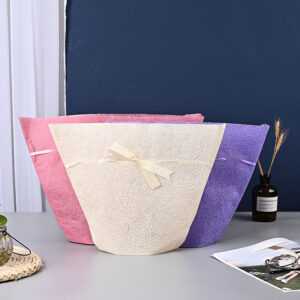Embossed nonwoven fabric has gained significant popularity in various industries for its unique texture, enhanced functionality, and aesthetic appeal. Porcelana, known for its manufacturing prowess, has emerged as a leading producer of embossed nonwoven fabric. This article explores China’s expertise in embossed nonwoven fabric production, highlighting its applications, manufacturing techniques, and contributions to the global market.
Understanding Embossed Nonwoven Fabric
Embossed nonwoven fabric is a type of nonwoven material that undergoes a specialized process to create raised patterns or textures on its surface. This process involves the application of heat and pressure to the fabric, resulting in a three-dimensional design. The embossing technique enhances the fabric’s visual appeal, texture, and functional properties.
Applications of Embossed Nonwoven Fabric
tela no tejida en relieve, also known as patterned or textured nonwoven fabric, is a type of nonwoven material that has a raised or recessed pattern on its surface. This pattern is created during the manufacturing process by applying heat, presión, or chemicals to the fabric. The embossing enhances the visual appeal and functional properties of the fabric, making it suitable for various applications. Here are some common applications of embossed nonwoven fabric:
- Hygiene Products: Embossed nonwoven fabric is widely used in hygiene products such as diapers, sanitary napkins, and adult incontinence products. The embossed pattern helps improve the softness, breathability, and fluid distribution capability of these products.
- Wipes: Embossed nonwoven fabric is commonly used in wet wipes, dry wipes, and cleaning wipes. The embossed pattern enhances the fabric’s absorbency and provides texture for effective cleaning.
- Medical and Surgical Products: Embossed nonwoven fabric is utilized in medical and surgical products like surgical gowns, cortinas, mascarillas, and caps. The embossing can improve the fabric’s barrier properties, strength, and aesthetics.
- Packaging: Embossed nonwoven fabric is used in packaging applications, including gift wraps, bolsas de compra, and product packaging. The embossed patterns can enhance the visual appeal and texture of the packaging material.
- Home Furnishings: Embossed nonwoven fabric finds application in home furnishings such as upholstery, cortinas, manteles, and bedding. The embossed patterns add texture, design, and durability to these products.
- Automotive Interiors: Embossed nonwoven fabric is used in automotive interiors for components like headliners, door panels, and seat covers. The embossing can provide a luxurious look, improve tactile feel, and increase durability.
- Filtration: Embossed nonwoven fabric is employed in various filtration applications, including air filters, liquid filters, and dust bags. The embossed patterns can increase the surface area, improve particle capture efficiency, and enhance the overall filtration performance.
- Clothing and Fashion Accessories: Embossed nonwoven fabric is used in clothing and fashion accessories like handbags, shoes, and belts. The embossing adds texture, design elements, and durability to these items.
Manufacturing Techniques
China embossed nonwoven fabric manufacturers employ various techniques to create unique patterns and textures. Some common manufacturing techniques include:
- Hot Embossing: This technique involves passing the nonwoven fabric through heated rollers or plates with engraved patterns. The heat and pressure applied during the process create raised designs on the fabric’s surface.
- Ultrasonic Embossing: Ultrasonic waves are used to create embossed patterns on the nonwoven fabric. The high-frequency vibrations generate heat, which melts the fabric’s fibers and creates the desired texture.
- Calendering: This technique involves passing the nonwoven fabric through heated rollers, which compress and shape the fabric, creating embossed patterns. The pressure and temperature applied during calendering determine the depth and design of the embossed texture.

China’s Contribution to the Global Market
China’s expertise in embossed nonwoven fabric production has made it a significant contributor to the global market. The country’s manufacturers offer a wide range of embossed patterns, textures, and fabric compositions to meet diverse industry requirements. China’s contributions to the global market include:
- Cost-Effective Solutions: China’s embossed nonwoven fabric manufacturers provide cost-effective solutions without compromising on quality, making embossed fabrics accessible to a wider range of industries.
- Customization: Chinese manufacturers excel in offering customized embossed nonwoven fabric solutions, allowing customers to choose specific patterns, textures, and fabric properties to suit their unique needs.
- Innovation: China’s embossed nonwoven fabric industry is known for its continuous innovation, introducing new patterns, textures, and functional enhancements to meet evolving market demands.
China’s expertise in embossed nonwoven fabric production has positioned it as a leading player in the global market. The country’s manufacturers offer a wide range of embossed patterns and textures, catering to diverse industries such as hygiene, embalaje, home furnishings, and automotive interiors. With its commitment to innovation and cost-effective solutions, China’s embossed nonwoven fabric industry is poised for further growth and technological advancements, contributing to the ever-expanding applications of embossed fabrics worldwide.